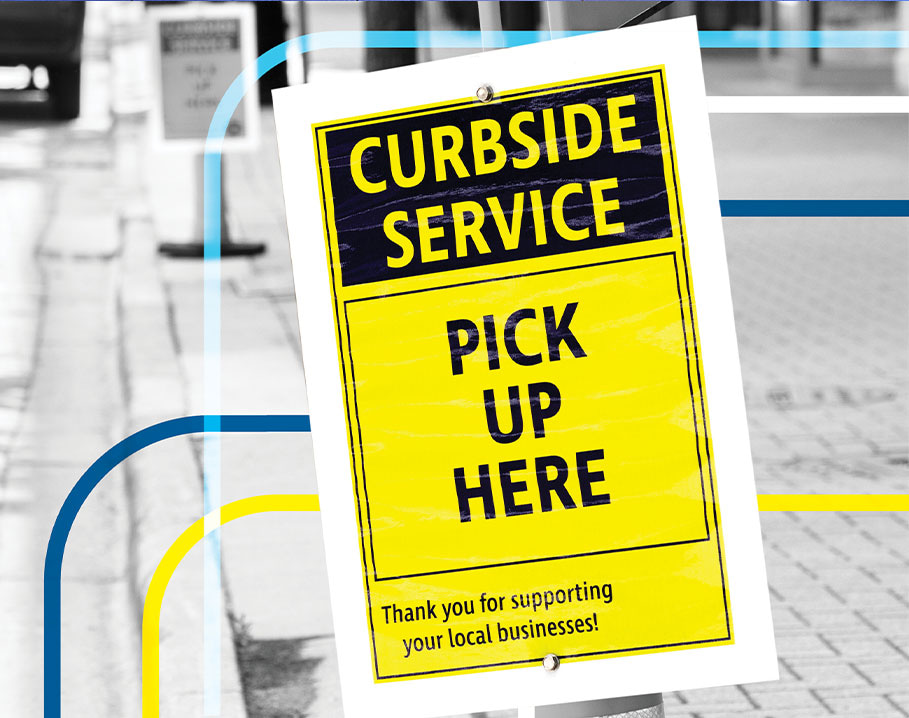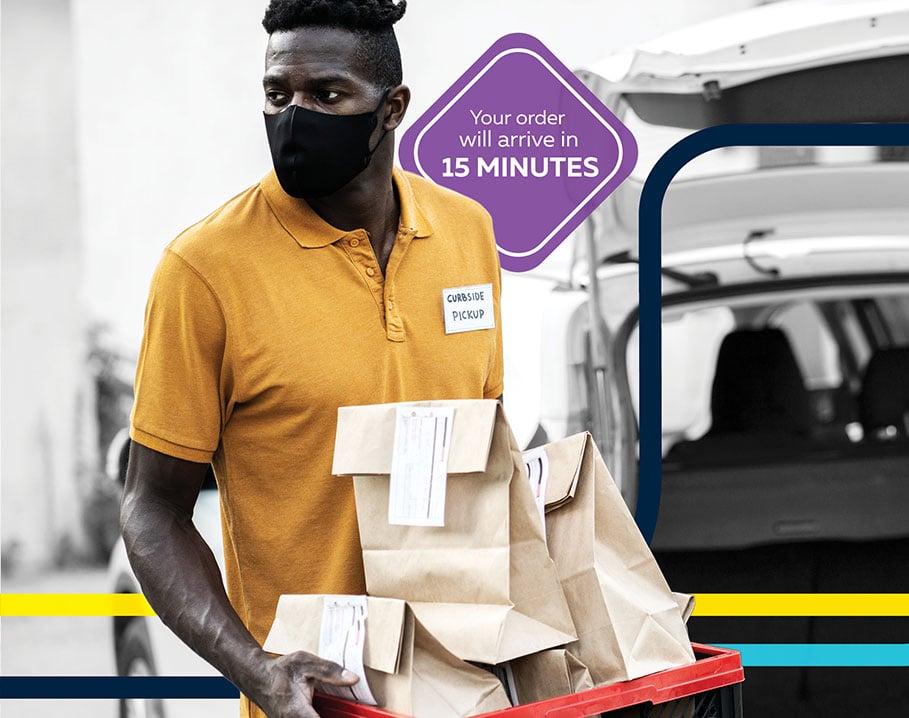
Unified Digital Experiences at Scale
How to Construct an End-to-End Customer Journey
The Change Agent
The global pandemic clearly changed customer behaviors—perhaps permanently. Brands must evolve their approach to address those changes and drive growth, as they bridge their digital and customer experience (CX) strategy.
Focus Your Strategy to Unify the Brand Experience
The customer experience and the way brands interact with customers forever changed in 1994. AT&T purchased a small rectangle on HotWired.com, and the digital marketing era was officially off and running. Fast-forward past the introduction of search engines, the rise of social media and the iPhone, and we find ourselves in an era where digital is ubiquitous.
As marketing dollars have aggressively migrated to digital marketing over the last decade, the volume of digital messages consumers are exposed to has skyrocketed. Market leaders understand that canned marketing techniques and generic messaging quickly bore an increasingly savvy consumer. Creating a consistent customer journey is a critical component of brand strategy.

It provides a clear roadmap for brands to build engaging customer experiences for their target audience. They know that a cohesive customer journey, focused on specific buyer personas, elevates the entire brand experience. They realize that simply being digital no longer qualifies as a differentiator. Future-focused brands are activating a holistic strategy, building end-to-end, frictionless experiences for their customers.
Companies have been evolving how they connect customers digitally to their brands for years. Whether through email, web, social, mobile and everything in between, brands have been building new experiences for their customers at an ever-increasing pace and scale. They aspire to blur the boundaries between the digital world and physical environments and deliver seamless experiences across multiple touchpoints. Then, a global pandemic forced lockdowns and restricted in-person contact. The digital experience was suddenly the only means of reaching their customer—and it happened, quite literally, overnight.
By 2023, U.S. digital marketing spend is expected to reach
$150billion
Someday, we’ll return to in-person gatherings and experiences. But the global pandemic has clearly changed customer behaviors—perhaps permanently. Brands must quickly evolve their approach to address those changes if they haven’t already. Organizations can drive growth as they bridge their digital and CX strategy, but only if they understand and execute on the following:
- Agility is the key to success: Reaching customers with personalized content at the right time and in the right context is critical for survival.
- Connecting digital and physical experiences: Orchestrating brand experiences across digital and physical experiences fuels customer delight.
- Use data to drive decisions: The pandemic highlighted how quickly customer behaviors can change and made clear that brands must use data-driven insights to inform strategic decision-making.

Market Perspective
A fireside chat with Seismic Customer Success Director Ben Anderson about how brands can integrate technology to enable a better digital experience for their customers.
Personalization Enabled by Technology
How has the pandemic impacted the ways brands communicate with their target audience?
Ben Anderson (Seismic): Along with a dramatic increase in using digital tools to communicate, we have seen a distinct shift toward personalization and storytelling as an effective model for connecting with your target audience. At this time last year, we all had to become experts in remote working, selling and communicating. Initially, this was simply getting to terms with the tools and understanding how to use them at a functional level. However, as the year progressed, becoming an expert in these tools to effectively communicate with your audience was essential for success. You can’t just jump into a digital meeting with a client and have a conversation in the same manner that you may have picked up the phone or stopped by for an in-person visit before the lockdowns. You must be prepared to craft your message to your audience and engage them across the digital medium. Today, you must be able to connect at a personal level through an inherently impersonal medium. To overcome this built-in disconnect, successful organizations are framing these conversations as storytelling, both through the way they address their topic and also the technology they are using. You must create content that is more engaging or interactive and customized to your client’s specific challenges, rather than static and extending into social selling. Establishing yourself as a trusted expert in your field through social channels, while not new, is playing an even more significant role today than it did a year ago and will continue to do so. I expect our “New Normal,” as it settles into a rhythm, will only see the continuation and refinement of all the adjustments we experienced in this last year. These were, on some level, good lessons in adaptability and creativity.

What criteria is most important for organization when evaluating new tools or technologies that enable a better digital experience for their customers?
BA (Seismic): The easy approach is simply to consider the most feature-rich offering that fits the category of tool you seek and matches the available budget expectations. This requires finding the tool and partner that best align with your organizational goals and philosophy along with meeting the features, functions and budget requirements. However, the harder approach is finding the path that will yield the most beneficial choice to the organization. With that said, when it comes to the tool itself, I look to these six categories:
- Ease of use – How many buttons do I have to click to use this thing?
Regardless of the inherent power of a tool, if the workflow is forced and complicated, it is challenging to gain the intended value. - Flexibility – What can it do that I didn’t think of?
A tool with multiple ways to leverage core functionality that can be bent to easily bring value to different use cases, departments or regions will be beneficial in initially unplanned ways. - Integration points – Can I use this thing in conjunction with the other tools you make me use?
Meeting users where they are in their workflow is invaluable in ensuring efficiency. - Breadth of offering – Can this tool also replace this other system I have?
A tool with a forward-thinking roadmap and a comprehensive offering can continue to evolve with your organization and changing times. - Ability to measure – Can I get metrics that indicate what is happening, and can I prove ROI?
Detailed measurability is table stakes for any digital-oriented tool, although the real key is ensuring that ROI can be identified through evaluating any metrics gathered. - Vendor relationship – Are you going to abandon me after the sale and implementation?
More and more, a close partnership with your vendor of choice is critical. The best partners invest in your success and ensure you are seeing value.
Along with a dramatic increase in using digital tools to communicate, we have seen a distinct shift towards personalization and storytelling as an effective model for connecting with your target audience.
 Ben AndersonCustomer Success Director, Seismic
Ben AndersonCustomer Success Director, Seismic
How do technologies such as sales and marketing platforms enable organizations to create personalized content and experiences for customers?
BA (Seismic): Mass personalization at scale is hard. The best tools are going to provide a powerful combination of capabilities and control that ensure you are leveraging them to the degree that brings the most value to your organization. Ideally, a tool is going to be easy to use and flexible while still providing control and command from the marketing side to ensure consistency and adherence to brand standard.
On trend today are tools that allow a seller to customize a deck, an email or a social post with a few clicks, and then deliver that to their prospect or client from within the workflow they are already in on a daily basis. On the back end, tracking the results from that outreach is a proven method for driving better engagement and ultimately recognizable ROI.
For the marketing team, it is also about how easy it is to set up, configure and manage those slide decks, emails and social posts that allow the seller to easily customize and also ensure the right level of control over the content itself and the level of branding required.

What types of metrics should organizations use to measure success?
BA (Seismic): The goal for any metrics evaluation should be attributing action to a measurable outcome that identifies ROI, and that will vary by organization. There are tactical, foundational and strategic metrics that are important to any organization. They serve distinct purposes in both what a key measure is and what that means to the business.
Tactical/Foundational – Within the context of sales enablement, these are the “who,” “what” and some of the “why” metrics—who is using a system, what are they using when they use it and why they are using it in that way (what is the use case?). Knowing these things will help you recognize what content is beneficial and impactful, which will help the content owner team better prioritize what content to create in the future, saving time and effort by not investing in low-value materials. Understanding who is using the system helps support the value of the system (adoption) and also recognize the usage trends of key constituent groups, which can be used for behavior modeling and to help feed the strategic-level metrics. Understanding how key constituent groups are using a tool will help illuminate whether the intended and communicated use case is being followed or undesirable habits are forming.
Strategic – Again, in the context of sales enablement, this is the application of “why” and “how,” mixed with data from other business systems to illuminate the efficacy of strategic initiatives. Does using this tool have a definable impact on our sales, revenue or cost structure, and what is the attributable percentage of that tool’s impact? This is the area I generally refer to as directional and not definitive, as we must always make some assumptions of the correlation impact, which are imperfect. What metrics to focus on here really depends on what is important to your organization and how a tool that you are measuring is intended to support those goals.
Our Perspective
One North leaders Kalev Peekna and Ryan Horner share CX insights on how brands can improve agility, orchestrate experiences across digital and physical domains, and how your data strategy should drive personalization.
Achieving Agility in CX
It’s well-documented that the events of the 2020 global pandemic accelerated digital transformation—from facilitating remote work to delivering products and services via contactless experiences, organizations across every industry have been challenged in new ways. Despite unprecedented disruption, the No. 1 digital transformation goal remains the same in 2021—improving the customer experience. Where brands may struggle is in adapting their strategy in a paradigm where customers are demonstrating unusual buying behavior. The 2021 Digital Trends Experience Index from Adobe indicates customers across all sectors are behaving in ways that are completely unpredictable. Fortunately, there is a roadmap for organizations to better understand the new buyer journey and improve the overall customer experience.
Half of B2C and B2B organizations reported unusual buying behavior from existing customers.1

Organizations are consumed with improving agility and increasing speed to market of products and services. Typically, agile transformation is directed toward development. “But true agility, whether from an operational standpoint, a product strategy perspective or from a design-and-build point of view, can only be achieved when considered holistically,” says One North’s Kalev Peekna. That approach helps brands overcome one of the biggest obstacles to improving their agility—an aversion to a true minimum viable product (MVP).
Organizations may embrace the concept of an MVP but often fall victim to the short-sighted view that the MVP is “not enough.” Organizational blockades frequently slow or stop an MVP from going to market. Organizations invest a lot of money and resources into agile transformation efforts, and an MVP may not look sufficient in the short term. Pressure may come from the C-suite, which needs to justify those investments to make an impact, so they try and stretch the MVP and bloat it with features to make a big splash. This approach inevitably fails because the organization hasn’t prioritized what’s most important. The MVP should be laser-focused on specific functions or users. Then, once feedback and data on what works and what doesn’t is gathered, the product can be recalibrated.
“Another way organizations gain quickness and flexibility is by aligning truly cross-disciplinary teams that have shared ownership of the outcomes,” notes Kalev. Too often, there are silos or a perception that the product is owned by a single function. The product owner then pursues a consultation-type model with other groups as they work to get the product to market. It’s essential to have the right stakeholders seated at the table from the beginning. Your team must include expertise from functions such as marketing, product, IT, design and line-of-business from day one. Then, you can create a relatively level playing field where each member contributes to the definition, design and delivery of the product based on their area of expertise.
Transformation is really about how brands apply a digital-first mindset to every customer interaction.
 Ryan HornerManaging Director, Technology, One North
Ryan HornerManaging Director, Technology, One North

Sometimes, you have to slow down to be better and faster. In many cases, speed to market is paramount and being first is an imperative. But not always. Organizations should always question whether being first is really the best strategy and examine the motives for pursuing that strategy. It can be a question of relative scale. If a competitor goes to market with a new product in April, but you deliver your product in June, has that put you at a significant competitive disadvantage? Apple wasn’t first to market with a smartphone. They did, however, learn from what competitors like BlackBerry delivered, and then improved upon that with a better customer experience. Sometimes, the key is to be better—not faster.
Digital vs. Analog
Today’s savvy consumer expects a frictionless brand experience, regardless of how or where that interaction takes place. Delivering a personalized experience, orchestrated across digital and physical domains, is quickly becoming table stakes. Consider this example: Your customer receives a relevant email promotion based on a previous purchase. They make the decision to purchase. Your mobile app, fueled by data-driven personalization, guides them through the order process, making recommendations and identifying the closest location to fulfill the order via curbside pickup. The experience thus far is seamless. But when they arrive, their positive feelings about a great brand experience evaporate. Poor or confusing signage outside the store leaves them confused. The customer doesn’t know how to alert the store they’ve arrived. Almost instantly, what had been a great customer experience has turned into a frustrating one. And the brand might not get a second chance.

For all the herculean efforts organizations put forth during the pandemic, examples like this prove there’s more to accomplish. Companies quickly stood up new services and delivery models to maintain business continuity and reach customers in new ways, and consumers were willing to allow for growing pains as everyone adjusted to the unprecedented circumstances. Now, however, brands must go back to the drawing board. They must evaluate the products and services created during the pandemic and decide what should be maintained, fine-tuned or retired. Then, armed with experience and data, they can thoughtfully and deliberately construct an end-to-end digital customer experience journey. Most organizations start with the better-understood elements of personalization, such as demographics, interests or order history. The next evolution of customer experience includes the notion of personalization according to context sensitivity.
Organizations are recognizing that they cannot make assumptions the way they may have in the past, in part due to shifting buyer behaviors during the pandemic. Leading organizations are asking deeper questions about the context of customer behaviors, taking into consideration how and where the customer is interacting with the brand. Are they on a mobile device? Is the customer physically in the store? Are they outside? Are they at home or at work? Based on this additional context, brands can create a better overall experience for their customers. “The key is to orchestrate an experience that seamlessly weaves the journey into a single path where behaviors are anticipated, and brick-and-mortar interactions mesh effortlessly with the digital experience,” says Kalev.
Data-Driven Personalization
Data is at the core of delivering personalized customer experiences. “Without data, you’re driving blind,” says One North’s Ryan Horner. Personalization is often driven by the experience design team, but to really be effective, it should start with the data strategy team. “Almost all personalization is not just data-centric, but data-driven,” says Kalev. Data by itself or out of context is just noise. “You really need a data science team to refine and define the metrics that matter—and then glean insights that tell a story,” adds Ryan. To drive the personalization you want, it’s critical to have the right data and an understanding of that data from the very beginning, which sometimes means changing your data strategy. Rarely do brands start with the right data to drive the personalization they want. There’s frequently a foundational step during which the organization must start collecting more of the right data in anticipation of fueling the personalized experience.
Almost all personalization is not just data-centric but data-driven.
 Kalev PeeknaChief Strategist, One North
Kalev PeeknaChief Strategist, One North
Next, clear KPIs must be established; then, perhaps most importantly, you must ask why you’re deploying personalization. It’s also critical to define where in the journey personalization will be deployed; otherwise, personalization efforts will fail or, at the very least, they will lack real impact. There are many great options for deploying personalization along the customer journey. Some options are incredibly complex and might be AI- or chatbot-driven. Other methods are relatively simple and don’t leverage as much technology. Really good personalization could be as simple as ensuring the right customers only receive the email promotions that are most relevant to them. When using data analytics to drive personalized experiences, brands should focus on the totality of the customer journey and pinpoint where on that journey personalization can deliver the most value.
TEKsystems’ Tips
- Be light, nimble and agile: Start small, then learn and adapt. What starts out as an MVP is often stretched into something far too polished. Focus your MVP on specific functions or users and refine it from there.
- Build inclusive design: Accessibility is often thought about first and is critical, but you also should consider context. Is my customer on a desktop or mobile device? When you create experiences that are accessible to everyone, you typically improve the entire experience.
- Have a design system: Make sure you have a full-on digital design system, so apps and sites all look and feel like they’re from the same company. Not only does this create a better overall brand experience, but it can also improve back-end system performance and efficiency.
- Strategy directed by data: The pandemic highlighted just how quickly customer behaviors can change. Brands must use data insights to drive strategic decision-making and deliver precise messages to their customers at the right time.
- Consider your martech holistically: Think about martech as a product within your business that can be used to create connected customer experiences. Silos break martech stacks; your technology must be fully integrated to harness that connection.
Real-World Application: Bumble
Personalization gets really personal when it comes to the multibillion-dollar online dating industry. The world of dating apps can be overwhelming to say the least. Users download apps and then just as quickly delete them if they have a poor experience. According to Pew Research Center, three in 10 adults have previously or are currently using a dating site or app. The companies that survive in this crowded market use data to drive personalized journeys for their users. But the market is wrought with apps that provide poor user experiences and unwelcome messages from other users that cause customers to abandon the app.
In 2014, Whitney Wolfe took a new approach when she founded the dating app Bumble. Rooted in kindness and respect, the platform differentiated the dating experience by enabling only the female users to initiate the conversation with a potential match. They’ve succeeded in growing their customer base by using data and machine learning to personalize matches based on your specific preferences. Growing to over 100 million users across six continents, Bumble has expanded far beyond a dating app into a networking platform, allowing people of all genders to make empowered connections in all areas of their lives, whether that means you’re seeking a romantic relationship on Bumble Date, making new friendships on Bumble BFF or growing your professional network on Bumble Bizz.
All information shared herein was accessed from public sources as indicated.
TEKsystems Digital Portfolio
- 700+ clients, including 50% of the Fortune 100
Delivering innovative solutions in creative and design, user experience, marketing technology, and strategy and operations. - 2,200+ digital placements across nearly every industry vertical
Through our Talent Services, we help clients augment, extend, accelerate or transform their digital business strategies. - Home to 3 of only 315 Sitecore MVPs worldwide
Recognized as exceptional professionals in the Sitecore community. - In good company
Transformational technologies demand equally transformative partnerships. TEKsystems is proud to deliver solutions across the full spectrum of leading platforms.
The views and opinions expressed in this publication are those of the authors and do not necessarily reflect the views of TEKsystems, Inc. or its related entities.



